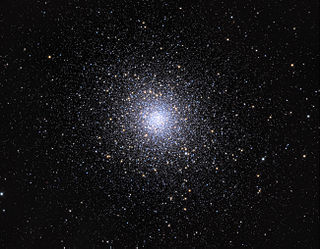
Messier 5 or M5 is a globular cluster in the constellation Serpens. It was discovered by Gottfried Kirch in 1702.

The Butterfly Cluster is an open cluster of stars in the southern constellation of Scorpius. Its name derives from the resemblance of its shape to a butterfly.

Messier 9 or M9 is a globular cluster in the constellation of Ophiuchus. It is positioned in the southern part of the constellation to the southwest of Eta Ophiuchi, and lies atop a dark cloud of dust designated Barnard 64. The cluster was discovered by French astronomer Charles Messier on June 3, 1764, who described it as a "nebula without stars". In 1783, English astronomer William Herschel was able to use his reflector to resolve individual stars within the cluster. He estimated the cluster to be 7–8′ in diameter with stars densely packed near the center.
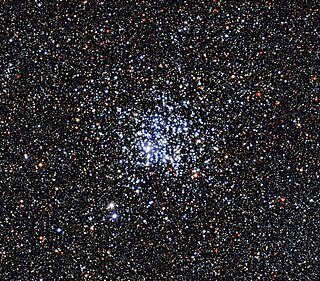
The Wild Duck Cluster is an open cluster of stars in the constellation Scutum. It was discovered by Gottfried Kirch in 1681. Charles Messier included it in his catalogue of diffuse objects in 1764. Its popular name derives from the brighter stars forming a triangle which could resemble a flying flock of ducks. The cluster is located just to the east of the Scutum Star Cloud midpoint.

Messier 21 or M21, also designated NGC 6531 or Webb's Cross, is an open cluster of stars located to the north-east of Sagittarius in the night sky, close to the Messier objects M20 to M25. It was discovered and catalogued by Charles Messier on June 5, 1764. This cluster is relatively young and tightly packed. A few blue giant stars have been identified in the cluster, but Messier 21 is composed mainly of small dim stars. With a magnitude of 6.5, M21 is not visible to the naked eye; however, with the smallest binoculars it can be easily spotted on a dark night. The cluster is positioned near the Trifid nebula, but is not associated with that nebulosity. It forms part of the Sagittarius OB1 association.

Messier 23, also known as NGC 6494, is an open cluster of stars in the northwest of the southern constellation of Sagittarius. It was discovered by Charles Messier in 1764. It can be found in good conditions with binoculars or a modestly sized telescope. It is in front of "an extensive gas and dust network", which there may be no inter-association. It is within 5° the sun's position so can be occulted by the moon.
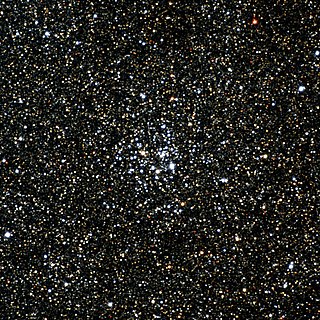
Messier 26, also known as NGC 6694, is an open cluster of stars in the southern constellation of Scutum. It was discovered by Charles Messier in 1764. This 8th magnitude cluster is a challenge to find in ideal skies with typical binoculars, where it can be, with any modern minimum 3-inch (76 mm) aperture device. It is south-southwest of the open cluster Messier 11 and is 14′ across. About 25 stars are visible in a telescope with a 150–200 mm (6–8 in) aperture.
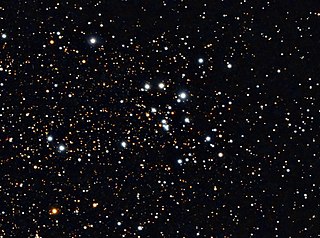
Messier 18 or M18, also designated NGC 6613 and sometimes known as the Black Swan Cluster, is an open cluster of stars in the constellation Sagittarius. It was discovered by Charles Messier in 1764 and included in his list of comet-like objects. From the perspective of Earth, M18 is situated between the Omega Nebula (M17) and the Small Sagittarius Star Cloud (M24).

Messier 35 or M35, also known as NGC 2168 or the Shoe-Buckle Cluster, is a relatively close open cluster of stars in the west of Gemini, at about the declination of the Sun when the latter is at June solstice. It was discovered by Philippe Loys de Chéseaux around 1745 and independently discovered by John Bevis before 1750. It is scattered over part of the sky almost the size of the full moon and is 2,970 light-years away. The compact open cluster NGC 2158 lies directly southwest of it.
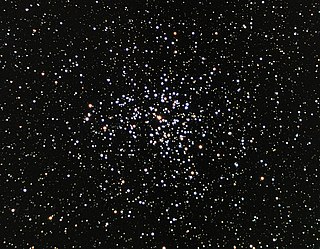
Messier 37 is the brightest and richest open cluster in the constellation Auriga. It was discovered by the Italian astronomer Giovanni Battista Hodierna before 1654. M37 was missed by French astronomer Guillaume Le Gentil when he rediscovered M36 and M38 in 1749. French astronomer Charles Messier independently rediscovered M37 in September 1764 but all three of these clusters were recorded by Hodierna. It is classified as Trumpler type I,1,r or I,2,r.
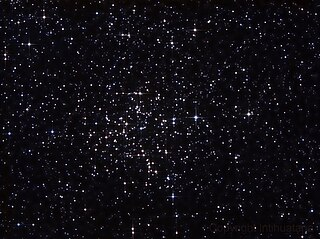
Messier 38 or M38, also known as NGC 1912 or Starfish Cluster, is an open cluster of stars in the constellation of Auriga. It was discovered by Giovanni Batista Hodierna before 1654 and independently found by Le Gentil in 1749. The open clusters M36 and M37, also discovered by Hodierna, are often grouped together with M38. Distance is about 1.066 kpc (3,480 ly) away from Earth. The open cluster NGC 1907 lies nearby on the sky, but the two are most likely just experiencing a fly-by, having originated in different parts of the galaxy.

Messier 39 or M39, also known as NGC 7092, is an open cluster of stars in the constellation of Cygnus, sometimes referred to as the Pyramid Cluster. It is positioned two degrees south of the star Pi Cygni and around 9° east-northeast of Deneb. The cluster was discovered by Guillaume Le Gentil in 1749, then Charles Messier added it to his catalogue in 1764. When observed in a small telescope at low power the cluster shows around two dozen members but is best observed with binoculars. It has a total integrated magnitude (brightness) of 4.6 and spans an angular diameter of 29 arcminutes – about the size of the full Moon. It is centered about 1,010 light-years away.

Messier 48 or M48, also known as NGC 2548, is an open cluster of stars in the equatorial constellation of Hydra. It sits near Hydra's westernmost limit with Monoceros, about 18° 34′ to the east and slightly south of Hydra's brightest star, Alphard. This grouping was discovered by Charles Messier in 1771, but there is no cluster precisely where Messier indicated; he made an error, as he did with M47. The value that he gave for the right ascension matches, however, his declination is off by five degrees. Credit for discovery is sometimes given instead to Caroline Herschel in 1783. Her nephew John Herschel described it as, "a superb cluster which fills the whole field; stars of 9th and 10th to the 13th magnitude – and none below, but the whole ground of the sky on which it stands is singularly dotted over with infinitely minute points".
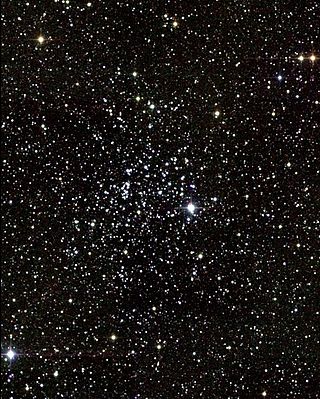
Messier 52 or M52, also known as NGC 7654 or the Scorpion Cluster, is an open cluster of stars in the highly northern constellation of Cassiopeia. It was discovered by Charles Messier in 1774. It can be seen from Earth under a good night sky with binoculars. The brightness of the cluster is influenced by extinction, which is stronger in the southern half. Its metallicity is somewhat below that of the Sun, and is estimated to be [Fe/H] = −0.05 ± 0.01.

Messier 53 is a globular cluster in the Coma Berenices constellation. It was discovered by Johann Elert Bode in 1775. M53 is one of the more outlying globular clusters, being about 60,000 light-years (18.4 kpc) light-years away from the Galactic Center, and almost the same distance from the Solar System. The cluster has a core radius (rc) of 2.18 pc, a half-light radius (rh) of 5.84 pc, and a tidal radius (rtr) of 239.9 pc.
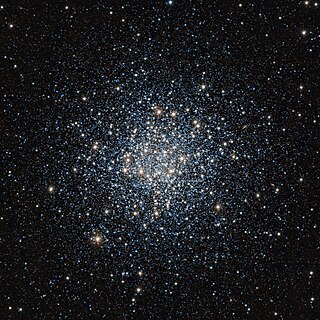
Messier 55 is a globular cluster in the south of the constellation Sagittarius. It was discovered by Nicolas Louis de Lacaille in 1752 while observing from what today is South Africa. Starting in 1754, Charles Messier made several attempts to find this object from Paris but its low declination meant from there it rises daily very little above the horizon, hampering observation. He observed and catalogued it in 1778. The cluster can be seen with 50 mm binoculars; resolving individual stars needs a medium-sized telescope.

Messier 68 is a globular cluster found in the east south-east of Hydra, away from its precisely equatorial part. It was discovered by Charles Messier in 1780. William Herschel described it as "a beautiful cluster of stars, extremely rich, and so compressed that most of the stars are blended together". His son John noted that it was "all clearly resolved into stars of 12th magnitude, very loose and ragged at the borders".
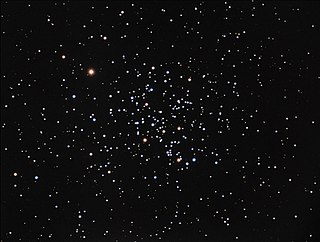
Messier 67 and sometimes called the King Cobra Cluster or the Golden Eye Cluster is an open cluster in the southern, equatorial half of Cancer. It was discovered by Johann Gottfried Koehler in 1779. Estimates of its age range between 3.2 and 5 billion years. Distance estimates are likewise varied, but typically are 800–900 parsecs (2,600–2,900 ly). Estimates of 855, 840, and 815 pc were established via binary star modelling and infrared color-magnitude diagram fitting.

Messier 93 or M93, also known as NGC 2447 or the Critter Cluster, is an open cluster in the modestly southern constellation Puppis, the imagined poop deck of the legendary Argo.

NGC 6530 is a young open cluster of stars in the southern constellation of Sagittarius, located some 4,300 light years from the Sun. It exists within the H II region known as the Lagoon Nebula, or Messier 8, and spans an angular diameter of 14.0′. The nebulosity was first discovered by G. B. Hodierna prior to 1654, then re-discovered by J. Flamsteed circa 1680. It was P. Loys who classified it as a cluster in 1746, as he could only resolve stars. The following year, G. Le Gentil determined it was both a nebula and a cluster.























